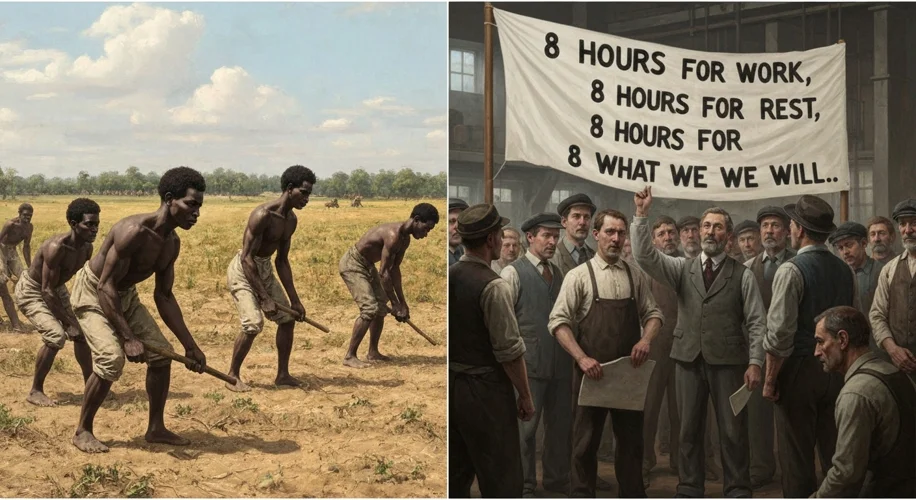The rhythmic clang of hammers, the relentless sun beating down, the ache in muscles pushed beyond their limits – these were the daily realities for millions of enslaved people throughout history. Their labor was the engine of economies, built on the backs of those denied their fundamental humanity. Meanwhile, in a world far removed from the brutal overseer’s lash, a different kind of labor revolution was brewing, one that would eventually champion the seemingly radical idea of an eight-hour workday.
But could the minds driving the institution of slavery have ever conceived of such a concept? Did they, like the industrial titans of a later era, recognize the point at which pushing laborers too hard yielded diminishing returns?
The answer, shrouded in the brutal logic of chattel slavery, is a complex and often agonizing one. While the formalization of the eight-hour workday emerged from a capitalist drive for productivity and worker welfare in the 19th and 20th centuries, the underlying principle of maximizing output through carefully managed labor hours was, in a twisted way, understood by slave owners. However, their understanding was fundamentally different, rooted not in the rights or well-being of the worker, but in the preservation of their “property.”
Consider the context of ancient Rome. The Roman elite, while benefiting immensely from the labor of enslaved people, were not unaware of the concept of overexertion. Roman agricultural writers, such as Cato the Elder and Columella, offered advice on managing enslaved labor. While their primary concern was the efficiency and longevity of their workforce as assets, their writings hint at an awareness that worn-out slaves were less productive slaves. They discussed the importance of adequate food, rest, and even medical care, not out of compassion, but as a means to maintain the value of their human chattel.

Yet, this understanding was a far cry from advocating for a limited workday. For slave owners, the “workday” was effectively dictated by the demands of the task and the availability of daylight, or even artificial light, for those forced to labor through the night. The enslaved person’s body was not a fragile instrument to be carefully calibrated, but a resource to be exploited to its absolute limit. There was no concept of a “fair day’s work” or compensation for overtime, only the relentless pursuit of more labor, more production, and more profit.
The industrial revolution brought a new scale to this dynamic. Factories, with their insatiable demand for production, pushed workers to their breaking point. The “teamsters” and “mill girls” of early industrial America often toiled for 12, 14, or even 16 hours a day. It was this extreme exploitation that fueled the labor movements advocating for the eight-hour day.
Figures like Samuel Gompers, the first president of the American Federation of Labor, championed the slogan “Eight hours for work, eight hours for rest, eight hours for what we will.” This was a direct response to the dehumanizing conditions of industrial labor, where the relentless pace left no room for life beyond the factory floor. The argument was not just about fairness, but about productivity: a rested, healthier worker was a more efficient worker.
slave owners, however, did not face the same pressures. Their “workers” were not paid employees with the right to organize or cease work. The cost of replacing a broken-down or exhausted enslaved person was often seen as less than the potential profit lost by reducing their labor. The inherent value of the enslaved person was solely tied to their capacity to labor, not their individual well-being. Therefore, the notion of “diminishing returns” was interpreted differently. Instead of asking, “How can we optimize this worker’s output through reasonable hours?” the question was, “How much can we extract from this person before they are no longer of use?”
The brutal truth is that the institution of slavery inherently denied the very concept of a “fair” or “limited” workday. The enslaved were property, and like any property, they were to be used and expended as their owners saw fit. While some owners might have practiced a degree of “care” to preserve their investment, this was a pragmatic calculation, not an ethical one. The fight for the eight-hour workday was a testament to the evolving understanding of labor’s value and human dignity, a stark contrast to the enduring legacy of exploitation inherent in the system of slavery.
It highlights a profound difference in how societies value labor and human life. While industrial capitalism, in its more enlightened forms, began to recognize the long-term benefits of worker well-being, the deeply entrenched system of slavery prioritized immediate profit above all else, even at the ultimate cost to the exploited individual.

